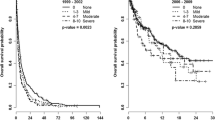Abstract
Dyspnea, or breathlessness, is a very distressing and prevalent symptom for patients with terminal cancer. Assessment for this symptom is generally poorly conducted, and it is therefore frequently underdiagnosed and inadequately treated. This paper outlines several tools found in the literature that may be beneficial to us in assessing this symptom. There will also be a full report on the application of these scales as used in a hospital audit of all in-patients at the Queensway- Carleton Hospital in Nepean, Ontario, during the month of June 1995. Results of this hospital audit revealed that 33% of all patients in hospital complained of some degree of breathlessness on both the Linear Analogue Scale Assessment and the Borg Scale. However, when the Modified Medical Research Council Dyspnea Scale and the Oxygen Cost Diagram Scale were used 75.6% and 78.5% respectively now complained of significant shortness of breath interfering with their quality of life. We also found that patients experiencing dyspnea were 39% more likely to complain of other symptoms than patients with no shortness of breath and were 55% more likely to report other symptoms as being severe. A short section will also outline the medical and nursing management of dyspnea and will include a discussion of possibly correcting the cause of breathlessness, environmental issues, and pharmacological management of dyspnea. It is advocated that during the terminal stages of a patient's illness, when assessment tools are no longer feasible or possible, that a “breathing comfortably” approach be adopted for patient and family comfort.
Similar content being viewed by others
References
Ahmedzai S (1993) Palliation of respiratory symptoms. In: Doyle D, Hanks GWC, MacDonald N (eds) Oxford textbook of palliative medicine. Oxford University Press, New York, pp 349–378
Brown M (1985) Selecting an instrument to measure dyspnea. Oncol Nurs Forum 12: 98–100
Bruera E, Stoutz N de, Velasco-Leiva A, Schoeller T, Hanson J (1993) Effects of oxygen on dyspnoea in hypoxaemic terminal cancer patients. Lancet 342: 13–14
Bruera E, MacEachern T, Ripamonti C, Hanson J (1993) Subcutaneous morphine for dyspnea in cancer patients. Ann Intern Med 119: 906–907
Chrubasik J, Wust H, Friedrich G, Geller E (1988) Absorption and bioavailability of nebulized morphine. Br J Anaesth 61: 228–230
Corner J, Plant H, Krisanasamy M, Bailey C (1995) Clearing the air. Nurs Times 91: 42–43
Cowcher K, Hanks G (1990) Longterm management of respiratory symptoms in advanced cancer. J Pain Symptom Manage 5: 320–330
Editorial Review (1995) Physician leadership — comfort measures only. Issues and Outcomes July/August: 7–9
Farncombe M, Chater S, Gillin A (1994) The use of nebulized opioids for breathlessness: a chart survey. Palliat Med 8: 306–312
Gift AG (1989) Validation of a vertical visual analogue scale as a measure of clinical dyspnea. Rehabil Nurs 14: 323–325
Gift AG (1989) Visual analogue scales: measurement of subjective phenomena. Nurs Res 38: 286–288
Gleeson C (1995) Blood transfusion and its benefits in palliative care. Palliat Med 9: 307–313
Hain R, Patel N, Crabtree S, Pinkerton R (1995) Respiratory symptoms in children dying from malignant disease. Palliat Med 9: 201–206
Heyse-Moore LH, Ross V, Mullee MA (1991) How much of a problem is dyspnoea in advanced cancer? Palliat Med 5: 20–26
Krech RL, Walsh D (1991) Symptoms of pancreatic cancer. J Pain Symptom Manage 6: 360–367
Nield M, Kim MJ, Patel M (1989) Use of magnitude estimation for estimating the parameters of dyspnea. Nuts Res 38: 77–80
Reuben DB, Mor V (1986) Dyspnea in terminally ill cancer patients. Chest 89: 234–236
Roberts D, Thorne S, Pearson C (1993) The experience of dyspnea in late-stage cancer. Cancer Nurs 16: 310–320
Author information
Authors and Affiliations
Rights and permissions
About this article
Cite this article
Farncombe, M. Dyspnea: Assessment and treatment. Support Care Cancer 5, 94–99 (1997). https://doi.org/10.1007/BF01262564
Issue Date:
DOI: https://doi.org/10.1007/BF01262564




